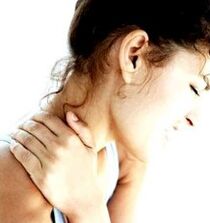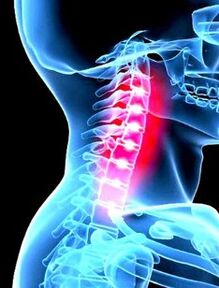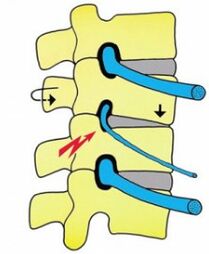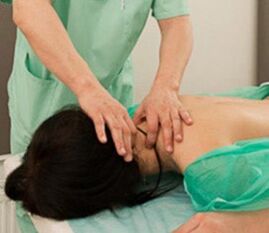Cervical osteochondrosis is a disease that is a dystrophic and degenerative disorder of the cervical discs of the spinal cervix. The cervical department is the most mobile, the muscular corset of this department over others is much weaker. The neck performs the rotation and inclination of the head, so the spinal column in this area is subject to deformities, destruction, hernia and bending formations.

The main causes of the disease
It is proven that osteochondrosis is a disease that "becomes new". Now this disease is increasingly found among people aged 18 to 30, while previously 40 cases were considered the norm. The reasons for this can be distinguished from the following:
Osteochondrosis, in essence, is a consequence of muscle clips, muscle spasm eventually moves the movement of the cervical spine, disrupts blood circulation, exacerbates blood supply to bone and muscle tissue, which provoke the development of dystrophic processes in diving and vertebrates, narrowing the lists. As a result - squeezed nerve roots and loss of sensitivity.
Symptoms of cervical osteochondrosis
Cervical osteochondrosis has a variety of symptoms. However, for the most part, the manifestation of osteochondrosis affects the circulatory system. In the cervical region there are many blood vessels that intensely nourish the brain. Therefore, the risk of osteochondrosis is associated with a poor supply of the head organs, especially the brain, blood. What signs of osteochondrosis of the cervical back will be expressed is affected by the segment that has been defeated. Therefore, the following signs of cervical osteochondrosis are distinguished:

What are the symptoms of cervical osteochondrosis if Rooseer's syndrome is characteristic? Rooser syndrome in medicine is called cervical radiculitis, occurs due to nerve clamps in the neck. The pain arises in the neck, descend on the shoulder blades area, may be lower in the shoulder and forearm, up to the fingers. Characteristic signs of cervical osteochondrosis in this case are experiences and tingling, burning senses, consequences, numbness of hands, forearm or fingers.
The symptoms of osteochondrosis of the cervical region will have different, which the segment fell under the damage to the disease would affect their change. If the central nerve and its roots are affected, the aftermath will be medium, index, and thumb. If the roots of the shoulder nerve are affected, then the Pasose will be a small finger and a ring finger. Cervical spine osteochondrosis, symptoms will have the following syndrome as irritating-reflex. The main feature will be the presence of acute, intense, burnt pain in the cervical region and consumption or in the neck itself. The pain tends to increase during movement or loads, is particularly acute after a static condition. For example, after sleep, with incorrect head curves, after sleep. The cervical osteochondrosis of the symptoms of the symptoms has similar because with the development of this syndrome, the pain is transmitted to the chest. It is diagnosed in cases where the damage area is not limited to the neck, but goes to the chest segments. Symptoms indicate a greater spectrum of cervical osteochondrosis, most importantly of them being a violation of the work of the internal organs.
Artery syndromeCord - irritation of cervical osteochondrosis, symptoms indicate themselves extremely intensely and consist of severe and burnt pain. Pulsing pain in the temples, the presence of severe migraines, which particularly amazes the parietal part, the back of the head and the swollen region are characteristic. The pain is chronic, persistent, but sometimes they record cases of paroxysmal pain. Irritation of the osteochondrosis of the cervical spine expresses symptoms in the form of increased pain. This happens after you have been in unpleasant poses, with unexpected movements, serious physical exercise. The irritation threatens with hearing disorders - a vestibular disorder, experiencing ears noise as well as a decrease in hearing sharpness. Vision problems are not uncommon. Osteochondrosis of the cervical spy symptoms with cardinal syndrome. Cardinal syndrome is characterized by severe pectoris of angina. It makes it difficult to identify the primary disease - osteochondrosis. Diagnosis "osteochondrosis of the cervical region" is often performed in a timely manner, as they try to diagnose the angina pector and treat it, this threatens the passage of osteochondrosis into a chronic form.

The phenomenon of angina pectoris is provoked by squeezing the spine into the lower segments of the cervical region, which finds a reflex response. Cardinal syndrome can manifest in cases where the roots of the chest or diaphragmatic nerve are irritated. Osteochondrosis of the cervical spine symptoms with cardinal syndrome can manifest in the form of tachycardia, extrasystole. There are frequent cases when osteochondrosis of the cervical region and hypertension also continue together. Similarly, the symptoms of cervical osteochondrosis are symptoms, its treatment does not always emerge in time, as doctors initially diagnose cardiovascular disease, and not osteochondrosis.
Symptoms and treatment of cervical osteochondrosis
A particular syndrome is diagnosed by the predominance of certain symptoms, treatment is already performed on the basis of this. Treatment is performed in two ways: whether radical, implying surgical intervention, or a conservative method. In those cases, if conservative treatment has not yielded results, an indicator for the operation is determined. Osteochondrosis of the cervical region is eliminated by the following methods:
Symptoms of cervical uterine osteochondrosis Tablet treatment
Typically, medication treatment is prescribed in cases where symptoms include the presence of severe pain. In fact, the pills are not a remedy due to the pain - osteochondrosis itself. The tablets are also described if the temperature for cervical spine osteochondrosis has increased. This symptom indicates the presence of inflammatory processes in the body, inflammation of the tissues and nerves should be eliminated.

Cervical osteochondrosis, symptoms, treatment and gymnastics
An effective and affordable method of treatment is considered to be a complex of exercise therapy and gymnastics. Exercises are aimed at increasing the flexibility of the cervical back, increasing the distance of the discussion between, strengthen the muscles that would protect the spine from damage and damage. Also, gymnastics and exercises very effectively establish the functioning of the circulatory system, this not only promotes bone tissue, but also allows us to normalize blood flow to the brain. The main thing is to perform exercises under the supervision of a doctor.
Cervical osteochondrosis, symptoms and treatment of surgery
If conservative treatment did not produce results, the operation is prescribed. It ensures the removal of processes, arches and ligaments, as well as the removal of hernias falling into the spine canal. After this procedure, cases of total instability of the cervical region are not uncommon. After surgery, a special support collar is prescribed to the patient, which stabilizes a weak neck and temporarily supports it.
As a rule, if you diagnose the disease in a timely manner, keep your doctor's strict recommendations and get involved in comprehensive conservative therapy, then osteochondrosis is significantly regulated, in many cases a view of complete recovery is observed.

























